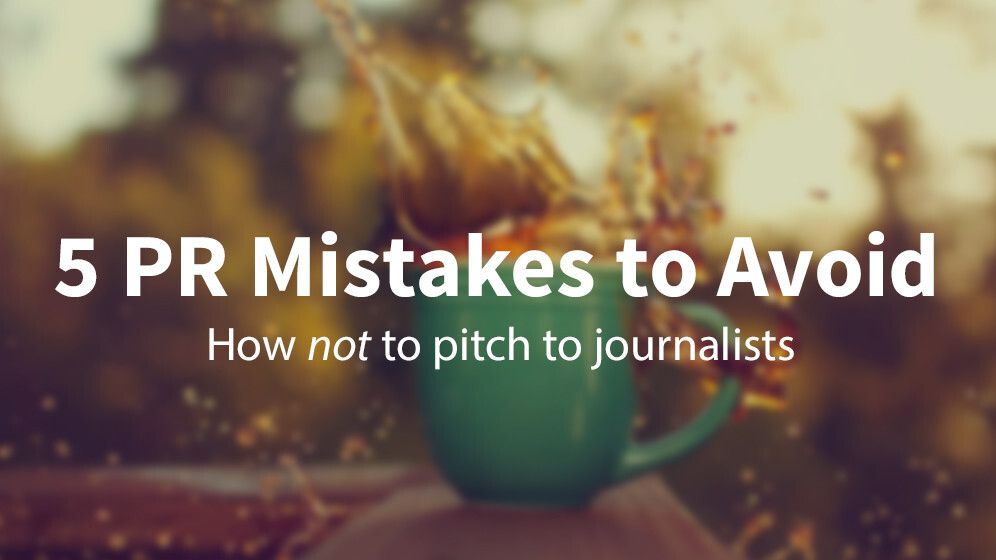
Conrad Egusa is the CEO of Publicize. He is happy to connect on LinkedIn here.
Successful people know how to learn from their own mistakes. Really successful people know how to learn from the mistakes of others.
Here are some of the most common PR blunders that you can learn to avoid in the first place.
1. Taking the press for granted
PR requires a concerted effort. It does when your company is a billion-dollar corporate giant, and it especially does when your company isn’t.
The most fundamental mistake you can make in PR is assuming that, by virtue of being interesting, cutting-edge, groundbreaking or whatever other superlative you like, your company is somehow entitled to press.
Media coverage isn’t a favor and it isn’t going to come out and find you. News outlets are businesses: businesses that traffic in news. In order to get press, you have to convince the press you have news to offer.
What qualifies as news? Well, that varies depending on the publication and writer and what exactly your business consists of. But these are a few standard announcements every business should be looking to use as launch platforms for outreach:
- Product Launches: You’re starting your business or releasing a new product
- Fundraising: You’ve just raised a Series A
- Milestones: Your company’s mobile app reaches 100,000 downloads
- Acquisitions: Your company acquires, or is acquired by, another company
Do your research and pitch to the right outlet and person.
2. Gabbing on and on
Most pitches will fail, regardless of how well you craft them. But one of the best ways to get your email dumped straight into the trash bin is to send journalists what looks like a copy of your latest memoirs.
According to a recent survey by MuckRack, 59 percent of journalists want pitches to come in at two or three paragraphs, while 36 percent of journalists said two to three sentences.
Meanwhile, only 5 percent want to receive pitches that are more than 500 words. The survey found length was the second biggest reason pitches were rejected.
That’s only fair. Entrepreneurs should be familiar enough with the elevator pitch scenario, and for the same reason you wouldn’t expect an investor to want to listen to all the intimate details of your business operation up front, you shouldn’t count on journalists to take that kind of time, either.
A pitch is just a teaser. Don’t try and write the article for them.
If there’s some particularly vital piece of information, you can always add it in an attachment, but offering to send it over later is a better call to action.
Here is an actual email pitch my company sent out that got back very positive feedback from a journalist. It’ll take some experimenting to finesse the art of the pitch, but with practice, you’ll learn what works and what doesn’t.
Hi [redacted],
Hope aIl is well. If you are too swamped to reply, no worries. I just wanted to give you a heads up about the $1 million raised by Startup Stock Exchange (SSX), which allows investors to use the security and liquidity of a regulated stock exchange to invest in startups from around the world, particularly Latin America.
For many companies in Latin America looking to raise funding, there is a limited market of investors (and often times the terms are not fair). SSX enables international start-ups and small businesses to attract qualified global investors on a regulated public stock exchange.
After reading the articles on your site (I particularly thought the The Periodic Table of Content Marketing was neat), I thought SSX might peak your interest.
If you may be interested, we are more than happy to arrange an interview. However, we completely understand if you ultimately decide not to publish.
If this pitch isn’t right for you at the moment, thanks again for your time and energy and I hope you have a good rest of the day.
Andrew Wright
Marketing, Publicize
3. Ignoring the timing
Journalists are extremely busy people whose professional – and often non-professional – lives are spent chasing one frantic deadline after another. But there are times when they’re less busy than others, and those are the times you probably want to be reaching them.
According to the MuckRack survey, 27 percent of journalists prefer to be contacted between 6 and 9 AM and another 43 percent between 9 to 11 AM. That is to say, roughly 70 percent of journalists want to be contacted in the morning.
It’s easy enough to understand why that might be. As the day drags on, work piles on top of unexpected obligations on top of ordinary backlog, and before you know it, it’s time to go home and worry about everything you didn’t get accomplished.
We’re all familiar with how that goes. Now picture what it’s like in a setting as fast-paced as a newsroom.
The same principle applies to the work week in general. By the time Friday rolls around, most journalists are just hoping to survive until the weekend.
It’s hard enough to stand out amid all the other stories competing for a journalist’s attention. Email early in the day and early in the week to ensure your pitch isn’t also vying against accumulated stress and sleep loss.
4. Coming off cold and impersonal
You can put all the time and care in the world into crafting a personalized email pitch, but if there’s nothing in the text itself to show that, a journalist is going to assume, by default, that she was on the receiving end of a chainmail sent to 50 of her colleagues. And she is going to press delete.
Over a quarter of journalists surveyed by MuckRack said the main reason they rejected email pitches was a spammy, impersonal feel.
One main explanation for this aversion is that cold, standardized text makes journalists assume other journalists are also being presented with the same pitch, and the news industry puts a high value on being the first to a story. Even just on the level of interpersonal exchange, though, making an extra effort to tailor a pitch can pay dividends in the future.
Remember that with PR, the goal isn’t just to get a given pitch picked up, it’s to set a positive tone for a relationship going forward. Gaining someone’s ear is half the battle.
Here’s some advice to follow:
Know the journalist you are pitching to: There’s plenty you can do to feign personal interest, but ultimately, nothing will work as well as actually getting to know the journalists you’re hoping to pitch to.
What do they like to cover? What angles do they go for? How can you cater a pitch to fit their interests? (Including their name in the greeting line rather than a “Dear editor” is a good start.) Staying up to date with the media landscape will help you come pitch time, but it’s also good standard policy for understanding market trends and understanding the news business.
Connect on social media: Fortunately, the internet has created unprecedented access to journalists and the publications they work for. Stay active on social media. Join discussions. Retweet your favorite writers.
As silly as it may sound, social media is one of the first places journalists will look to gauge you and your company. Maintaining an engaged professional network and keeping up with the latest is one way to convey seriousness. It also tells a journalist that any story they write on you can count on reaching a certain guaranteed audience.
Include social proof in email pitch: Even in the digital age, and perhaps especially in the digital age, all the traditional status symbols still carry weight. If you carry a card in any field, play it.
If your school has a heavy name, drop it. The same goes for awards and the like. Don’t spend half the email buttering yourself up, but don’t worry about coming off as pretentious either. It’s okay to mention your achievements.
Be polite: This may seem like a no-brainer, but you’d be surprised how far a few kind words will take you and at how many people eschew the common courtesies altogether.
Thank journalists for their time and attention. And show them you mean it by keeping your requests reasonable and your email concise.
5. Forgetting to follow up
Never assume your emails have gotten read and never assume a lack of response means they haven’t. Outreach is the first step in PR, but following up is an implicit part of that.
If you haven’t received an email back after a day or two, it won’t hurt to send another email checking in on how things are going.
Delays are common in PR, and as often as not, a journalist who doesn’t respond has either forgotten to or never found the time. Either way, they’ll appreciate a reminder. It’s never good to be pushy, but as long as you’re polite and concise, you don’t have to worry about coming off that way.
Here’s what a standard follow-up email looks like, using the same example from above:
Hey [redacted],
It’s Andrew again, checking in to confirm that you got my previous email, regarding the story on the SSX fundraising announcement.
If you’re busy and didn’t get a chance to get around to it, that’s fine. I just want to make sure it didn’t get lost in a spam folder.
Thanks again for your consideration. Look forward to hearing from you.
Best,
Andrew
Good PR is about getting a foot in the door. Avoiding these common mistakes won’t get you coverage, but they will keep you from banging your head on the doorframe.
Read next: How to make your conference or event journalist friendly
Get the TNW newsletter
Get the most important tech news in your inbox each week.






